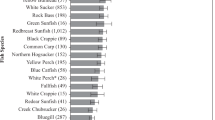Abstract
As a continuing part of the National Contaminant Biomonitoring Program, the U.S. Fish and Wildlife Service collected freshwater fish at 112 monitoring stations in 1978–1979 and 1980–1981. Three composite samples of three to five fish were collected at each of about half of the stations in odd-numbered years and at the other half in even-numbered years, and analyzed for lead, mercury, cadmium, arsenic, selenium, cooper, and zinc. The geometric means, minimum, and maximum of elemental concentrations (μg/g wet weight) during 1978–1979 and (in parentheses) during 1980–1981 were as follows: Pb 0.19, 0.10–6.73 (0.17, 0.10–1.94); Hg 0.11, 0.01–1.10 (0.11, 0.01–0.77); Cd 0.04, 0.01–0.41 (0.03, 0.01–0.35); As 0.16, 0.04–2.08 (0.14, 0.05–1.69); Se 0.46, 0.09–3.65 (0.47, 0.09–2.47); Cu 0.86, 0.29–38.75 (0.68, 0.25–24.10); and Zn 25.63, 7.69–168.1 (23.82, 8.82–109.2). The 85th percentile, calculated for station mean concentrations (μg/g wet weight) for 1978–1979 and 1980–1981, respectively, were: Pb 0.32 and 0.25; Hg 0.18 and 0.18; Cd 0.09 and 0.06; As 0.23 and 0.22; Se 0.70 and 0.71; Cu 1.14 and 0.90; and Zn 46.26 and 40.09. There was no significant upward or downward trend between collection periods of the national geometric means of any of the elements except for cooper which decreased significantly. Species differences in elemental concentrations contributed more variability to the data set than did station differences. The proportion of the collections composed of each species changed little between collection periods. Thus, the magnitude of the species effect on the national geometric mean of each period was probably fairly consistent; however, it precludes our making sound comparisons among various regions of the United States. As a participant in the National Contaminant Biomonitoring Program (NCBP), the U.S. Fish and Wild-life Service is responsible for monitoring temporal and geographic trends of organochlorine chemical and elemental contaminants in the nation's fresh-water fish, European starlings (Sturnus vulgaris), and waterfowl. Primary emphasis has been placed on organochlorine chemical contaminants; however, certain elements have been measured intermittently and additional elements have been added periodically since 1969. We summarize the concentrations of the seven elements—lead, mercury, cadmium, arsenic, selenium, copper, and zinc—measured in freshwater fish collected during 1978–1981. Data for earlier collections have appeared in other reports (Hendersonet al. 1972; May and McKinney 1981; Walshet al. 1977).
Similar content being viewed by others
References
American Fisheries Society, Committee on Names of Fishes (1980) A list of common and scientific names of fishes from the United States and Canada (4th edition). Am Fish Soc Spec Publ 12, Bethesda, Maryland
Barber RT, Whaling PJ, Cohen DM (1984) Mercury in recent and century-old deep-sea fish. Environ Sci Technol 18:552–555
Carlander, KD (1969) Handbook of freshwater fish biology. Volume 1. Iowa State University Press, Ames, Iowa
Fiorino JA, Jones JW, Caper SG (1976) Sequential determination of arsenic, selenium, antimony, and tellurium in food via rapid hydride evolution and atomic absorption spectrometry. Anal Chem 48:120–125
Foley RE, Spotila JR, Giesy JP, Wall CH (1978) Arsenic concentrations in water and fish from Chautauqua Lake, New York. Environ Biol Fish 3:361–367
Henderson C, Inglis A, Johnson WL (1972) Mercury residues in fish, 1969–1970—National Pesticide Monitoring Program. PesticMonit J 6:144–160
Kavin RW, Buono JA, Fasching JL (1976) Removal of trace elemental impurities from polyethylene by nitric acid. Anal Chem 48:2296–2299
Koirtyohann SR, Khalil M (1976) Variables in the determination of mercury by cold vapor atomic absorption. Anal Chem 48:136–139
May TW (1982) Recovery of endogenous selenium from fish tissue by open system dry ashing. J. Assoc Offic Anal Chem 65:1140–1145
May TW, McKinney GL (1981) Cadmium, lead, mercury, arsenic, and selenium concentrations in freshwater fish, 1976–1977-National Pesticide Monitoring Program. Pestic Monit J 15:14–38
Mertz W (1981) The essential trace elements. Science 213:1332–1338
Moody JR, Lindstrom RM (1977) Selection and cleaning of plastic containers for storage of trace element samples. Anal Chem 49:2264–2267
Phillips GR, Russo RC (1978) Metal bioaccumulation in fishes and aquatic invertebrates. US Environmental Protection Agency, Ecol Ser, EPA-600/3-78-103. Washington, DC
SAS Institute, Inc (1982) SAS User's Guide: Statistics, 1982 Edition, SAS Institute Inc, Cary, North Carolina
Schmitt CJ (1981) Analysis of variance as a method for examining contaminant residues in fish: National Pesticide Monitoring Program. Pages 270–298 In: Branson DR, Dixon K (eds) Aquatic toxicology and hazard assessment, fourth conference, ASTM-STP 737. American Society for Testing and Materials, Philadelphia, Pennsylvania
Schmitt CJ, Ludke JL, Walsh D (1981) Organochlorine residues in fish, 1970–1974 National Pesticide Monitoring Program. Pestic Monit J 15:136–206
Schmitt CJ, Ribick MA, Ludke JL, May TW (1983) Organo-chlorine residues in freshwater fish, 1976–1979: National Pesticide Monitoring Program. US Fish Wildl Serv Resour Publ 152, Washington, DC
Scott WB, Crossman EJ (1973) Freshwater fishes of Canada. Fish Res Board Can, Bull 184, Ottawa, Canada
Tam GKH, Lacroix G (1979) Recovery studies of selenium using dry ashing procedure with ashing aid. J Environ Sci Health B14:515–524
Underwood EJ (1977) Trace elements in human and animal nutrition, 4th ed. Academic Press, New York
Varanasi U, Markey D (1978) Uptake and release of lead and cadmium in skin and mucus of coho salmon (Oncorhynchus kisutch). Comp Biochem Physiol 60C:187–191
Walsh DF, Berger BL, Bean JR (1977) Mercury, arsenic, lead, cadmium, and selenium residues in fish, 1971–1973—National Pesticide Monitoring Program. Pestic Monit J 11: 5–34
Wiener JG, Giesy JP (1979) Concentrations of Cd, Cu, Mn, Pb, and Zn in fishes in a highly organic softwater pond. J Fish Res Board Can 36:270–278
Author information
Authors and Affiliations
Rights and permissions
About this article
Cite this article
Lowe, T.P., May, T.W., Brumbaugh, W.G. et al. National Contaminant Biomonitoring Program: Concentrations of seven elements in freshwater fish, 1978–1981. Arch. Environ. Contam. Toxicol. 14, 363–388 (1985). https://doi.org/10.1007/BF01055413
Received:
Revised:
Issue Date:
DOI: https://doi.org/10.1007/BF01055413




